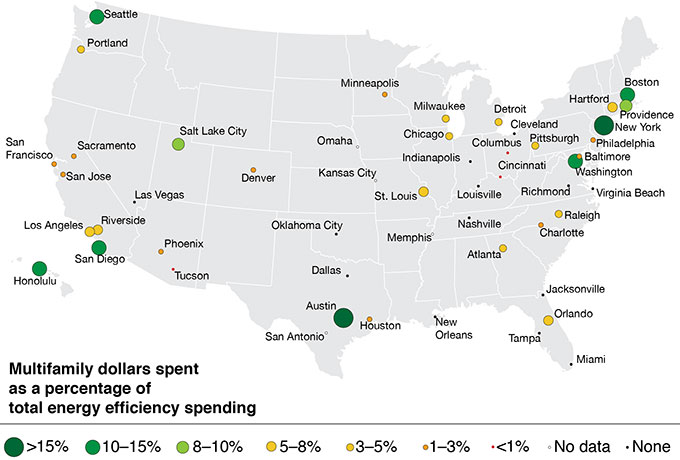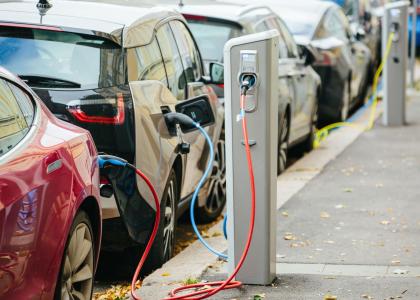Today, one in six American households resides in the apartments or condominiums of multifamily buildings. While new multifamily buildings are being constructed across the country, most residents still live in older buildings that are not energy-efficient. ACEEE’s newly released report provides encouraging news for apartment and condo dwellers who want to reduce the cost of their energy bills. Utility-sector energy efficiency programs that serve these buildings have nearly tripled their spending in recent years. While these programs still face challenges, many are expanding the products and services they offer to upgrade buildings.
Addressing the Challenge of Retrofitting America’s Multifamily Buildings
Historically, energy efficiency programs have not sufficiently served the multifamily sector. As ACEEE identified in a report last year, it can be difficult to effectively market efficiency programs to the owners and managers of multifamily buildings, who face many competing priorities for their time and resources. They may find it difficult to navigate an efficiency program’s application process or obtain financing for upgrades. Program managers have also struggled to convey the total benefits of efficiency upgrades, which can include not only energy savings but also reduced operation and maintenance costs, improved tenant satisfaction, and healthier indoor environments.
Multifamily Energy Efficiency is Improving
ACEEE’s new report More Savings for More Residents: Progress in Multifamily Housing Energy Efficiency, examines energy efficiency programs serving the 51 metro areas with the most multifamily households. It documents those programs that have successfully tackled the above challenges and expanded their capacity to serve the multifamily market. In 2015, these programs spent $291 million in the nation’s largest multifamily markets to provide incentives and no-cost measures that upgrade apartment and condo buildings. This level of spending is nearly triple the spending that ACEEE estimated in its 2013 report, Scaling Up Multifamily Energy Efficiency Programs: A Metropolitan Area Assessment. Not only has spending increased, but it also occupies a greater share of many utility-sector energy efficiency budgets as seen on the map below.
Today, multifamily programs are available in 38 of the nation’s 51 largest markets – an increase of eight markets since ACEEE’s 2013 assessment. Most of these programs offer both the direct installation of no-cost efficiency measures and financial incentives for building upgrades. The number of markets offering programs to retrofit entire buildings and building systems – programs that achieve the greatest energy savings – has also increased. Comprehensive retrofit programs only served 16 markets when ACEEE conducted its initial assessment of multifamily programs, but today these programs serve 25 markets.
What is Driving Multifamily Program Expansion
State-level policy, regulation, and funding are the primary drivers of utility energy efficiency investments – including those made in multifamily buildings. As ACEEE’s State Energy Efficiency Scorecard documents, many states have recognized a need to increase energy efficiency spending and adopt policies that encourage the creation and expansion of efficiency programs.
Many local governments have adopted energy benchmarking policies requiring that multifamily owners track their buildings’ energy use and report how it compares with similar local buildings. These policies have helped building owners identify the need for energy efficiency investments and, in some municipalities, required owners to upgrade their buildings.
Through its Multifamily Energy Savings Project, ACEEE continues to work with utilities, community organizations, and government agencies to create new multifamily programs while improving and expanding others. Our ongoing work includes researching program best practices, offering technical assistance to utilities, and facilitating an ongoing working group for program administrators.
Remaining Challenges
While multifamily programs are more common now than several years ago, challenges remain for this sector. Multifamily energy efficiency spending across the 51 largest markets only accounts for an average of 6% of total efficiency spending. By way of comparison, sales of electricity and natural gas to multifamily properties comprised 11% of all sales in 2009. Many metro areas still lack comprehensive building retrofits programs. Thirteen large metro areas have no multifamily programs at all.
Low-income multifamily buildings are particularly underserved. Low-income families often struggle to find homes that have both affordable rents and energy costs. There are currently only 15 metro areas that have programs targeting multifamily buildings with low-income renters. ACEEE, along with partners such as Energy Efficiency for All, are working to increase the number of programs serving these households. ACEEE is conducting a multi-year low-income research initiative focused on documenting program best practices and opportunities for improvement and expansion.





